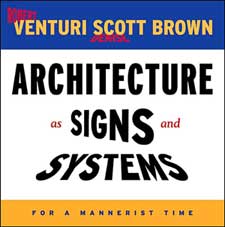
Book Review
Architecture as Signs and Systems: For a Mannerist Time
Cambridge, MA: Harvard University Press, 2004
251 pages. Photographs, line drawings, schematics; illustration credits, and index
$35.00 (hardcover), ISBN 0-674-01571-1
There can be little doubt that the art of illusion, the art of the television screen and of electronic fantasy, will play a considerable role in the architecture of the future, much as painting and sculpture did in the architecture of the past.
—Vincent Scully, “Robert Venturi’s Gentle Architecture,” 1989
Architecture as Signs and Systems is an overview of the mannerist sensibility as traced through the extensive practice portfolio of Venturi Scott Brown, whose outlook on architecture as a creative enterprise has shaped the latter twentieth century and continuing. This record tracks the development of a sensibility focused on style and surface, conceiving architecture as a primarily visual medium—as signboard and image rather than as a pure method of building in 3D.
These are style architects who have left their signature mark around the globe for five decades, including the Sainsbury Wing of the National Gallery in London, Franklin Court in Philadelphia, the San Diego Museum of Contemporary Art, and many others. From venerable old-school campuses like Penn and Princeton to cafes and gas stations (and a McDonald’s themed to Disney near Orlando) to government buildings in France and highrises in China, theirs is the mark of mannerism, perhaps the most important aesthetic operating in building design today.
Based on a series of lectures on American Civilization at Harvard in 2003, this book illustrates the changing ideas about aesthetic ideals that have shaped the built environment over time. An overview of Venturi and Scott Brown’s design careers and thinking across the decades since the late 1960s illuminates much about human and American values not just in design and building but in urban planning and global developments. These mark the current multicultural style of global metropolitanism.
These designers have treated tradition as the content of art, beyond style templates or models. Part of this renaissance is owed to new industrial materials that can replicate any era or construction method—themeing landscapes of urban and suburban spaces with art styles of the past as a way of giving new life to antiquated sensibilities. In this way their work focuses on adapting modes of feeling and seeing as well as building to problems of new building as well as updating and readapting old spaces to new uses.
Witness the strip-scape of Las Vegas as a visual experience. The city is a virtual world tour from New York City to Old Europe to the Middle East and back to Paris and Italy (the topic of their book, with the late Steven Izenour, Learning from Las Vegas, in 1972). But the intent is not to rebuild blocks or cities in high gothic or beaux arts or even the international style, but to put those styles to work within a “scenographic” new order that references the catalog of older styles in a sophisticated re-viewing. Along with their accomplished projects, this fully illustrated overview also includes plans and proposals never built. This stylebook of designs and their theoretical genealogies offer options to evoke mood appropriate to the setting—a technique first used in full force at Disneyland in 1955 within a symbolic landscape designed not by architects but by filmmakers and animators.
Chapter Four on “A New Mannerism for Architecture as Sign” proposes mannerism as the key sensibility for the twenty-first century. Mannerism uses modernism et al. as its raw content but spins it in the direction of the popular arts—commercial, communal, technological, and graphically symbolic—and away from the purity of manifestos of originality. Mannerism embraces complexity and contradiction, enveloping any and all styles within its grasp of irony, rule-breaking, eclectic aesthetics. It works by analogy and juxtaposition from outside any single style, by wit rather than literal observance within the style limits. Mannerism acknowledges multiple and layered meanings as the outcome of reinventing the conventions of established styles, from simple to complex, abstract to symbolic, drawn from a multicultural database. The epicenter of mannerism is Times Square; as the Piazza San Marco was a style mélange for the Renaissance.
Chapter Five, “Some Ideas and Their History,” opening with the South African setting of Scott Brown’s youth, looks at the genealogy of meta-style as the current outcome of the history of design ideas richly informed by received concepts--from fields as diverse as folk art, social activism, urban planning, psychology, cultural geography, even theology.
The Venturi approach considers signs and symbols as place-makers in the mind, rather than building styles and materials outside it. The duo has formulated an architecture of communication—which is the way all great art has always had its effect on the collective mind. This challenging book raises questions about the purposes of architecture beyond containing space, but as a part of bigger systems like perception, community, urban living, the highway system, and artistic expression as a communication that holds the receiver as the prime player in the equation.
Communication by cultural iconography rather than simply a master-planning expression on the architect’s part, operates in the “impure” netherworld running below and beyond the fine arts: that of popular culture, advertising, mass media and manufacturing, signage, the roadscape, industrial/technological design, and vernacular symbolism.
Between the universe of serious high-architectural commissions and the commonplace of shared popular culture has grown up a creative crossbreeding of the most rarified fine arts with the most common shared signs and symbols of popular culture. A third vector is the dynamics of commercial space as the “experience economy” for which building becomes the creation of art spaces for behavior. VSB has long anticipated and pioneered this type of space, one designed to be experienced by reference to many other times and places—as themed space-making based as much on mental as on material models.

